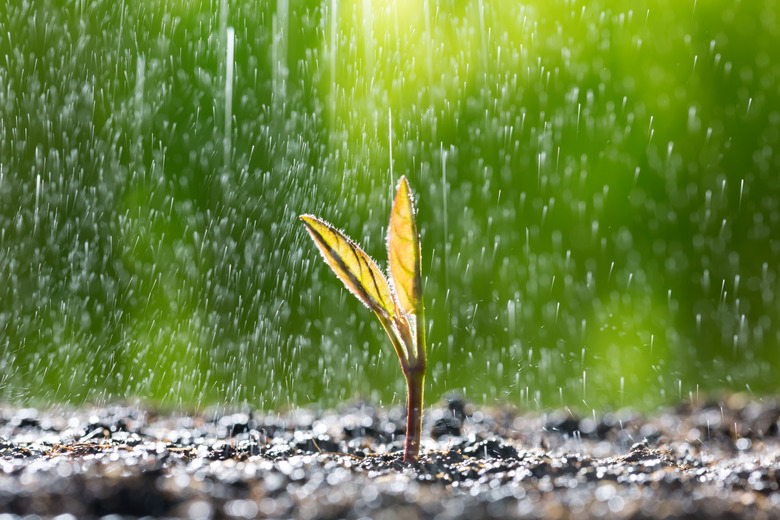The Effects Of Rain Water On Plants
Why do plants look greener after rain? Rainwater for plants is like drinking water for humans, in that it is essential for health, and plants always seem to perk up and look happier after a rain shower. Plants use water in a variety of ways, and water makes up as much as 95 percent of the body of a plant. From photosynthesis to carrying nutrients and cooling and supporting the structure of plants, water plays a number of roles in healthy functioning of plants.
Rainwater for Plants
Rainwater for Plants
Water not only helps seeds germinate and grow, but it also allows mature plants to absorb nutrients through dissolved minerals in the soil. Water in any form – from a garden hose or from the sky – will keep plants hydrated and healthy, but the nice thing about rainwater is that it waters everything all at once, with no effort on your part.
It's more effective to water plants at the ground level when you're using a hose, as plants take in most of the water they use through their roots. Moved through the plant by specialized vascular tissue called xylem, about 90 percent of the water that plants take up is recycled back into the atmosphere, through a process called transpiration. The other ten percent of the water is used for chemical reactions like photosynthesis, which requires sunlight and carbon dioxide to produce sugars to keep the plant alive.
As plants release water from their leaves through transpiration, the evaporation of water helps cool them and keep them from overheating. This water is replaced by moisture from the ground, which plants absorb through their roots. Changes in internal pressure help keep plants hydrated; water is pulled up through roots and vascular tissue when negative pressure is created through transpiration in leaves.
Does Rainwater Have Minerals?
Does Rainwater Have Minerals?
All water contains minerals, but the types and concentrations may vary with the source. Some minerals, which are also referred to as essential nutrients, are necessary for healthy plant growth and for the production of flowers and fruits.
Rainwater that falls to the ground usually filters slowly into the soil, where it will absorb ionized forms of essential plant nutrients like calcium and magnesium. Plants take up these minerals with water that is pulled up through roots, and these essential nutrients are distributed throughout the stems and leaves of plants through vascular tissue.
When watering plants with rainwater collected in rain barrels, there are a few things to keep in mind. Because bacteria and algae can grow in rain barrels, rainwater stored this way should not be considered potable. In other words, it is not safe for humans to drink, so it should not be used to water any plants that are edible. Use rainwater from rain barrels to irrigate only the non-edible plants in your landscape, like ornamental bushes and flowers.
The Right Amount of Water
The Right Amount of Water
Although some amount of water is needed by all plants, some plants require more than others. Succulents like cacti and sedums are adapted for low-water conditions like the desert, so they need less-frequent watering than other species. Some plants, like cattails and willows, are tolerant of soggy soils, while others, like peppers and tomatoes, do not do well with "wet feet."
Too much rainfall or hand watering may lead to fungal diseases or necrosis, which means plant death. On the other hand, too little water can also lead to necrosis. Signs that a plant is thirsty may include brown or curled leaves. A plant with "wet feet" may signal that it is overwatered by losing leaves, or leaves may wilt or turn yellow.
Generally, when the right amount of water is not being provided by rainfall, it's best to water plants at the ground level. Provide a good soaking at the base of each plant by hand-watering or using a soaker hose or drip irrigation system. Observe how different varieties respond to a rain shower or hand-watering, and if the plant has been thirsty, you'll likely see a growth spurt after a dose of water.
Cite This Article
MLA
Sloane, Christina. "The Effects Of Rain Water On Plants" sciencing.com, https://www.sciencing.com/the-effects-of-rain-water-on-plants-12390760/. 30 September 2021.
APA
Sloane, Christina. (2021, September 30). The Effects Of Rain Water On Plants. sciencing.com. Retrieved from https://www.sciencing.com/the-effects-of-rain-water-on-plants-12390760/
Chicago
Sloane, Christina. The Effects Of Rain Water On Plants last modified March 24, 2022. https://www.sciencing.com/the-effects-of-rain-water-on-plants-12390760/
